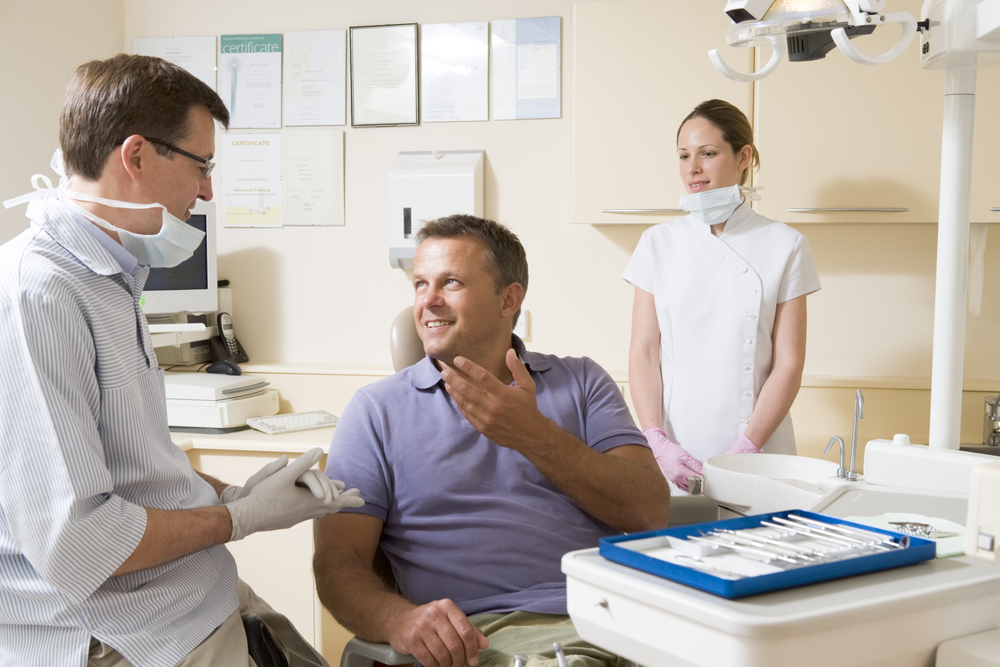
Your dentist has likely begun to perform oral cancer screenings during routine exams due to increased oral cancer cases. This straightforward screening catches problematic tissues as early as possible, and early detection makes successful cancer treatments much more likely.
If you’re feeling a little nervous about what to expect during an oral cancer screening, don’t be! The process is fast, simple, and there are even some signs you can watch for at home to prevent oral cancer from happening to you.
Oral Cancer Screenings Are Quick and Painless
An oral cancer screening is a two-part exam where your dentist will examine the oral cavity and connective tissues in the throat.
Step One: Visual Exam
Using a light, mirror, and tongue depressor to see more clearly, your dentist will perform a visual exam of the face, neck, lips inside your nose, and oral cavity. Your dentist will be looking for any indications of asymmetries, swelling, bumps, patches of color, ulcerations, or other abnormalities. This exam is much like your average physical you would receive at your doctor’s office, and it’s pain-free.
Step Two: Physical Exam
After the visual exam, your dentist will touch areas of the head, cheeks, around the jaw, under the chin, and in the oral cavity to feel for any unusual nodules or masses that are not visible with just the eye. Oral cancer symptoms can be painful, or in some cases, completely painless, so it’s imperative that your screening is thorough.
Oral Cancer Screening Tools
Your dentist will likely utilize specialized examination tools to complete an oral cancer screening.
These may include items like:
- An oral brush biopsy, which painlessly removes cells for testing.
- An enhanced oral assessment system tool to identify suspicious oral tissues with a fluorescent light.
- A mouth rinse to help with the visual inspection of your mouth’s tissues.
Oral Cancer Risk Factors
Due to genetics or lifestyle habits, some individuals are more likely to be diagnosed with oral cancer than others.
Some common risk factors include:
- Being Male. Men are twice as likely as women to develop oral cancer. It is thought that this may be related to men’s alcohol consumption and tobacco use.
- Age. Patients over the age of 50 have a higher risk of developing oral cancer, while the average age for diagnosis is 62.
- Tobacco Use. If you’re a smoker, you’re six times more likely to develop oral cancer than a non-smoker. Using chewing tobacco increases your odds of developing oral cancer by more than 50%.
- Alcohol Consumption. Consuming alcohol regularly makes you six times more likely to develop oral cancer than a non-drinker.
- Family History. Oral cancer is often thought to be genetic. If someone in your family has experienced oral cancer, you should notify your dentist and receive frequent screenings.
- Excessive Sun Exposure. The harmful rays of the sun cause damage to the skin tissue, which increases your risk of developing cancer.
- HPV. Certain strains of Human papillomavirus are likely to cause oral cancer.
Common Signs and Symptoms To Watch For
Unfortunately, early home detection of cancerous tissues in the mouth may not be noticeable to the naked eye. If you’re experiencing any of the following, see your dentist immediately for a professional screening.
- Bumps, rough spots, eroded areas, or swelling on the lips, gums, or inside the mouth.
- White, red, or white speckled patches in the mouth.
- Bleeding in the mouth.
- Numbness or tenderness in the mouth or on your face or neck.
- Sores on the face, neck, or mouth that bleed and are not healing.
- Chronic sore throat or feeling like something is caught in your throat.
- Difficulty chewing, swallowing, speaking, or moving the tongue.
- Hoarseness or change in vocalizations.
- Frequent earaches.
- Changes to your bite or your alignment.
- Extreme weight loss.
If Further Testing Is Necessary
If your dental professional does find oral cancer-like symptoms, they may refer you for further testing. Results that need further investigation do not necessarily lead to an oral cancer diagnosis. If oral cancer is detected and diagnosed, early diagnosis can help to reduce treatment-related health problems, so prevention and early detection are key!
A screening for oral cancer is not only a physical exam, but it’s also an opportunity for you to speak with your trusted dental professional about fears and concerns surrounding mouth cancer. Feel free to come prepared with any questions you may have and ask us for advice on lifestyle changes to reduce your risk.
If you’re at a higher risk for oral cancer, contact Hinsdale Dentistry to schedule your next screening.